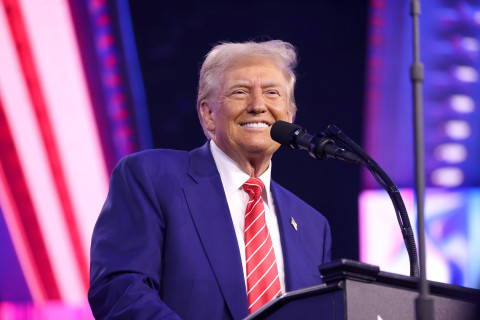Trump's Favorite Word: Tariffs
Topics
Regions
In October 2014, Donald Trump described "tariff" as the most beautiful word in the dictionary at a Chicago Economic Club meeting.1 This statement highlights the current volatility in the global economy. Trump's administration significantly impacted international trade policies by imposing substantial tariffs since April 2nd, particularly targeting China. This action suggests that the previous trade conditions may not return. Even if some countries negotiate better trade terms in the coming weeks, the escalation of tariffs marks a significant change in the 30-year period of free trade policies and their underlying discourse.

Gage Skidmore/Flickr/CC BY-SA 2.0
What drives the interest in tariffs by Trump? The press has suggested various reasons. These include the trade imbalance with China, which is notably in deficit for the US, the decline in national industrial employment since the 1990s, and the desire to regain some of the global economic influence that has shifted toward China. Each of these explanations contains elements of truth. They all point to the same broader phenomenon: the significant relocation of production by American companies since the 1980s, a process commonly referred to as globalization in international economics.
From this perspective, the issue extends beyond China itself. The primary concern is the impact of capital internationalization on the global hegemon. The relocation of production processes directly affected industrial employment in the United States, which, during the 1960s, was characterized by high productivity levels but incurred substantial costs for employers. In other words, the most productive labor force was also the most expensive. Advances in information and communication technology, coupled with improvements in transportation and logistics, allowed American companies to fragment the production process. Consequently, these companies relocated manufacturing operations to Southeast Asia, China, and India, retaining only brand management within their original territory. This phenomenon was aptly described by Naomi Klein in the late 1990s as "logo management."
From a state perspective, Trump's concerns are not unfounded: he is highlighting the impact of economic globalization on domestic industry. Firstly, productive relocation has diminished the United States' capacity to produce essential industrial materials such as steel. In addition, the production of chips and semiconductors, crucial for the space and defense industries, largely occurs outside U.S. territory, posing a risk to national security. Furthermore, industrial employment has significantly decreased over the past 30 years, leading to a decline in American productivity levels.
The situation viewed as problematic by the US government has resulted in significant gains for companies that capitalized on productive relocation. This process began after the collapse of the Soviet Union, which introduced former Soviet-occupied countries to the global market, presenting their comparative advantages. American and European companies benefitted from the favorable investment conditions offered by Asian nations eager for foreign capital.
These companies achieved unprecedented profits due to low labor costs, workers' lack of union experience, and local governments' guarantees of militarized production zones for export. State incentives played a crucial role in enabling companies to reach exceptional levels of productivity, yielding extraordinary profits. Additionally, China provided an expansive internal market with its one billion consumers. The increased efficiency in logistics and transportation significantly enhanced the flow of goods between ports and continents, resulting in optimized supply chains and minimized downtime. Furthermore, the extensive signing of treaties with clauses protecting foreign investments allowed investors to sue states in international arbitration over any regulation perceived as expropriatory. In summary, factors such as affordable labor, disciplined workforce, efficient supply chains, and strong legal protections for investments contributed to this substantial economic shift.
The lower incidence of the US in the global economy has its counterpart: the significant gains of American companies producing abroad. Currently, those most concerned about tariffs are the companies themselves. The change in the game rules generates uncertainty for them, particularly with regards to production in the United States. This would result in a considerable increase in costs, as American industrial workers earn higher salaries than their counterparts in China. Despite wage increases in China over the last decade, they still do not match the average salary of an American industrial worker. The wage difference for similar industrial jobs between Mexican and American workers remains significantly lower, by about six times.2 The cost implications of this shift are uncertain, and even with protection from tariffs (since protectionist policies create protective barriers for local capital), many companies anticipate a potential reduction in profit levels due to the increased costs of producing in the US.
Some industries move slowly and may require up to 10 years to relocate a significant portion of their production to the US. There is a substantial problem: a big part of the production process would need to be automated, replacing labor with robots. For instance, in Zhengzhou, known as "iPhone city," up to 300,000 workers are employed with specialized skills in small components.3 The US currently faces a shortage of specialized industrial labor, and there is limited interest among Americans in occupying these jobs, according to a survey by the CATO Institute in 2024.4
Companies that relocated from the United States to the East long ago do have the potential to return and produce domestically. However, the internationalization of productive forces has advanced to such an extent that it would be materially challenging, if not impractical, to confine them within national or regional borders. The fiscal and labor incentives required by Trump would need to be substantial, thereby positioning the state in a role that once again benefits concentrated economic groups. In the short term, tariffs could result in economic recession, inflation, and unemployment, which would predominantly impact the American working class.
